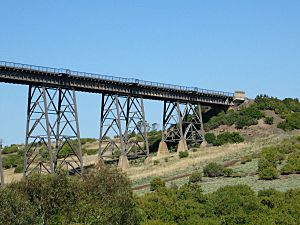Maribyrnong River Viaduct facts for kids
The Maribyrnong River Viaduct is a special railway bridge in Melbourne, Australia. It crosses the Maribyrnong River in the western part of the city. People sometimes call it the Quarter Mile Bridge because it's almost 400 meters long, which is about a quarter of a mile!
This bridge is mainly used by trains that carry goods, also known as freight trains. It's also part of the railway line that connects Melbourne to Sydney, carrying the CountryLink XPT passenger train.
Contents
The Maribyrnong River Viaduct
What is the Maribyrnong River Viaduct?
The Maribyrnong River Viaduct is a very important railway bridge. It helps trains travel across the Maribyrnong River. It's located in the western suburbs of Melbourne, near another large bridge called the E.J. Whitten Bridge.
This bridge is a key part of the Albion-Jacana railway line. It allows many different trains to cross the river safely. Most of the trains that use it are carrying goods, but it also carries passenger trains like the XPT, which travels between Melbourne and Sydney.
How Big is This Bridge?
The Maribyrnong River Viaduct is a truly impressive structure! It is 1257 feet (about 383 meters) long. This makes it a very long bridge for trains to cross.
It is also incredibly tall. The bridge stands about 180 feet (54.86 meters) above the water. This makes it the second highest bridge in Victoria, only a little shorter than the West Gate Bridge. To give you an idea of how tall it is, it's even higher than the famous Sydney Harbour Bridge!
Building the Bridge
The Maribyrnong River Viaduct was built a long time ago, between 1927 and 1929. The Victorian Railways Construction Branch was in charge of building it. When it was finished in June 1929, it was the largest trestle bridge in Australia. A trestle bridge is a type of bridge that uses a framework of beams to support the railway line above.
Building such a big bridge was a huge job! About 200 people worked hard to construct it. Today, the bridge is recognized as an important part of history and engineering. It is listed on the Victorian Heritage Register, which means it's protected because of its historical value.


